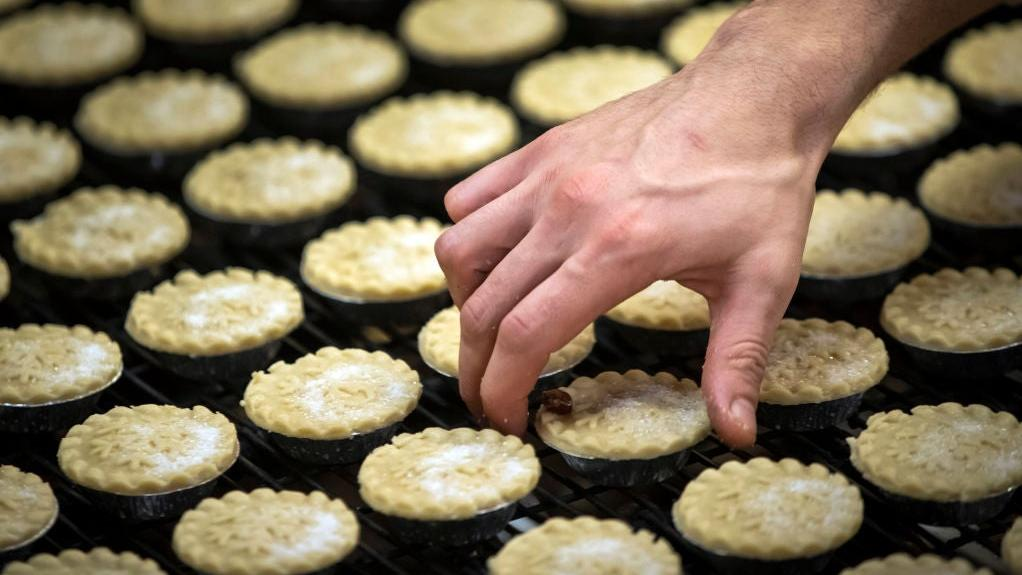Flaky, Buttery Pie Crust Is Within Your Grasp!
Even if you've never baked before, you can pull this off.
Plopping your pie filling into pallid, pathetic premade crust is nothing short of a tragedy. Crust makes up practically half the damn pie, and it matters just as much as everything else! There is no mass-produced dough in the supermarket that comes remotely close the flaky, buttery ecstasy of a homemade pie crust, so don't take the shortcut that makes your pie worse? People think making pie dough is hard, but here's the truth: it's really not.
You may have had many a pie dough disaster in your past, because I, too, had some disasters when I was first learning how to bake. That's because most recipes are written to be short and simple, and you're supposed to follow them to the letter. But making pie dough requires a recipe and intuition. And how do you develop intuition? You make pie dough.
I know you may be intimidated, that you doubt you can make a pie from scratch, but we believe in you! What's the worst thing that can happen? Your pie won't look like the ones on Instagram? Who cares. Pie crust is butter, sugar, and flour, so even if it looks like a hot mess it's still going to taste good.
Tips for perfect homemade pie crust
The dough will start off on the sticky side, and whenever things are sticky, all you need to do is dust them with flour. Do not worry that you're adding too much flour, because you can always brush off the excess, and as you roll and fold the dough, it will absorb the flour as it needs to.
(Pie dough will always tell you what it needs. If it's sticky, give it a little flour; if it's dry and cracking, give it a little water.)
When making this recipe, roll out the pie dough on parchment paper, which will make the folding step much easier. During the early steps it's going to look like an absolute disaster, so don't worry that you've done something wrong or that you're mangling it—it will come together. When you've finished rolling and folding (and repeating), you'll have something that is sturdy and pliable and feels a bit like Play-Doh.
Once your dough comes together, you can either use it right away or wrap it well and freeze for up to six months. This recipe makes enough for a double-crust pie, one large crostata, or two 9-inch pies.
Mega-Flaky Pie Crust
Makes enough for one double-crust pie, one large crostata, or two 9" pies
- 3 cups flour, plus an additional 1 cup for dusting
- ¼ cup sugar
- 2½ sticks cold butter
- 1 tsp. kosher salt
- ½-¾ cup ice cold water
- 1 egg beaten with 1 Tbsp. of water (aka egg wash)
First, prepare your environment: It's important that your kitchen is cool, so do not have the stove or oven on while you make pie dough. Prepare your rolling area by laying out a few sheets of aluminum foil to cover your counter, then lay a 2-foot-long piece of parchment down on top of it. Put one cup of flour in a little mound somewhere on the foil to use for dusting; sprinkle a generous amount over the parchment and your rolling pin.
Put the remaining 3 cups of flour in a bowl with the sugar and salt and stir together with a fork. Cut both sticks of butter lengthwise into quarters, then cut the eight butter batons into small pats about 1/4" thick. Toss them into the flour mixture, using your fingers to separate any that get stuck together so every little piece gets good and coated. Add the salt to the water and stir well, then slowly pour into the flour mixture, gently stirring with a fork. Keep adding water until there are no dry spots, then dump the dough out onto the floured parchment.
Dust your hands very well with flour and pat the dough down until it's rectangle-ish (no need to be perfect) and about 1" thick. Roll out the dough until it's 1/4" thick, dusting the sticky bits with flour as you find them. Your dough will not be a perfect rectangle. There might be crumbly bits around the edges. There will be thick, visible pieces of butter in the dough. This is all normal.
Next, fold the dough into thirds like brochure, lifting the parchment paper to assist you. The undersides of the dough will be sticky and may not come off the paper perfectly; again, that's normal. Just slap it together the best you can and sprinkle the sticky bits with flour. Once you have your dough brochure, fold the top and bottom up so they slightly overlap in the center, flip the dough over so the seam is on the bottom, and voila! You've got a dough square. Now, repeat that same rolling, folding, and flipping process one more time, adding a sprinkle of flour as needed. Once you're done, use your hands to pat the dough down into a 1" rectangle, wrap in the parchment, then wrap well in plastic and refrigerate for at least 2 hours.
